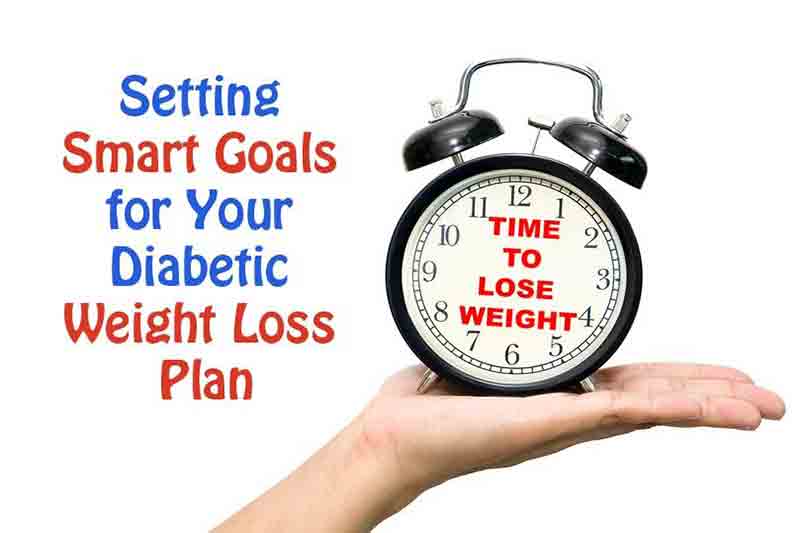Table of Contents[Hide][Show]
Happy January!!!
I hope the holidays have found you well.
While I’m sure you may have eaten foods and portions outside the normal routine, I hope you’ve not gotten yourself too far in the hole in terms of weight and blood sugar.
Regardless of whether you’ve taken a few steps backward, managed to maintain, or been an overachiever and actually achieved weight loss during the holidays (kudos to you!), January is a great time to focus on getting back on track with your healthy eating meal plan, blood sugar levels and physical activity.
The start of a new year is an excellent time to reflect upon the past year, examine where you have come, evaluate what is most important to you, and set some goals to help you arrive where you’d like to be a year from now.

Setting SMART Weight Loss Goals
When I say “goals,” I don’t mean things like, “I want to lose weight,” or “I’m going to really start eating better.”
Those are good starts, but how will you know if you’ve achieved them? How much weight do you want to lose? When do you want to lose it by? How will you measure the healthfulness of your diet?
See where I’m going?
In order to truly be successful, your goals should be SMART. This is a nice acronym to remember when coming up with a plan for success.
Let’s take a closer look at how this works.
S – Specific / Significant / Stretch
First things first. Your goals should be SPECIFIC.
The more vague your weight loss goal, the easier it will be to justify straying from it in your mind and the more difficult it will be to know whether you’ve accomplished it. Make your plan as detailed as possible.
For example, “I am going to lose 1 pound a week and aim to lose 12 by April.”
Then you can plan HOW you are going to do that.
Your goal should also be SIGNIFICANT – something that is important to you and be gratifying when accomplished. Add something motivating to the goal.
For instance, “I am going to lose 1 pound a week and aim to lose 12 by April because I’m tired of beating myself up and want to feel energetic and healthy.”
Lastly, it should STRETCH you.
For example, If you’re currently exercising 10 minutes per day, bumping that up to 11 isn’t going to bring that much benefit. You’ll easily get bored with a lack of results and lose motivation. Stretch yourself out of your comfort zone and you will reap much better rewards.
M – Measurable / Meaningful / Motivational
In order to know whether you’ve accomplished your goals, they must be MEASURABLE.
Avoid using general words like “more” or “less” and instead choose wording that is measurable.
For example, decide how many times per day you are going to exercise or reduce eating out, how many minutes you are going to exercise, how many carbs you’ll keep yourself to at meals and so forth.
Your goals should also be MEANINGFUL – these are your goals, not your doctors, not your spouses, not ours.
What matters to you most?
We harp on diet, exercise and weight as we know those are big struggles for people, but perhaps your biggest barrier right now is stress. That can affect your glucose levels, your weight, and a whole host of other health consequences. Maybe it’s time to start setting boundaries with family members or have conversations with friends.
Focus on what matters most to you as that will be most MOTIVATIONAL.
A – Action-Oriented / Attainable / Agreed Upon
Thirdly, plans should be ACTION-ORIENTED.
That is, they should focus mostly on what you are going to do rather than the outcomes hoped for.
While this doesn’t mean you can’t include weight loss or glucose lowering as an outcome, it does mean that the essence of your plan should focus on controllable factors – what you are doing to accomplish those outcomes.
For example, saying “I want to lower my blood sugar levels” is great but it’s not action-oriented. You know this is what you want to achieve (the outcome) but HOW will you do it?
Saying something like “I will evaluate the types of carbs I eat, cut the high carb foods, focus on eating non starchy vegetables at every meal and watch my portion sizes. I’m going to log all my food intake so I can really be in control.”
Now that is much more action oriented, right?
Your goal should also be ATTAINABLE.
This is the opposite extreme of the above “stretching” – it should take you outside your comfort zone…but not so far outside that you aren’t able to complete it. So increasing your exercise from 10 to 11 minutes/day is not stretching enough, but increasing it to 45 minutes of P90x or Crossfit is probably far too extreme to maintain. Start slow and build up.
Your goals should also be AGREED UPON by all parties involved. Trying to make healthier changes to your diet? If you have a family, they may not all be on board as you are. You may need to have several conversations with spouses or children to set forth some boundaries or guidelines.
It may look like this, “I’m really trying to manage my health better this year and eating right is very important to me. I will be preparing healthy meals from now on and would love to have you join me in this goal. If you are not willing, you are welcome to prepare something separate.”
This is just an example; obviously everyone’s family dynamic is different. But, it’s important that you take control and look after YOU.
Please pin, share or tweet this info, then keep on reading :)

R – Realistic / Results/ Relevant
Along the lines of attainable, goals should be REALISTIC.
Don’t commit to things that are outside your budget or availability. You may enjoy climbing mountains, but if you work a day job, you may have to settle for walking. A gym membership might be a fun idea but outside your budget. You may be really excited about gourmet recipes that take hours and many ingredients, but if you only have 20 minutes to prepare a meal after getting off work, you may need to simplify with 5 ingredient fast recipes.
Your plan should be RESULTS-ORIENTED and RELEVANT to what you want to accomplish.
If you are trying to lose weight, substituting organic blueberries for conventional – which is fine to do – is really not going to help you make much headway toward your goal as much as say watching your total calories or carbs and quality of food choices.
Our personal meal planner can help you calculate calories and carbs with the click of a button.
Watch this short video.
T – Time-Based / Trackable / Tangible
It’s very important that your plan is TIME-BASED.
Not only does this quantify an additional measurable factor making it TRACKABLE, but it also creates a sense of urgency. Knowing you have a deadline will help keep your goal at the forefront of your mind. As a tip, I recommend having many small short term goals leading up to larger goals.
For example, if you’re hoping to lose 100 pounds in a year…well that’s a long ways away and you can get discouraged waiting so long for results. Setting short term goals that will lead to the bigger goal but which you can achieve in a week or a month, will help curb that waiting period and keep you encouraged.
Lastly, your goals should be TANGIBLE. They shouldn’t not be abstract, but rather something you can put your finger on, something that someone looking in from the outside could identify, see and notice rather than a general feeling or fabrication in your mind.
As an example, “having a healthier outlook” is an intangible goal whereas, “writing out my negative thoughts and discussing them with my spouse each day” is tangible. Both are getting at the same idea, but one will be much more effective at achieving results.
So there you have it. All the tools you need to set some smart goals for this coming year.
We hope to be a resource as you embark on your journey for 2017 and would love to hear your goals in the comments section below!


Leave a Reply